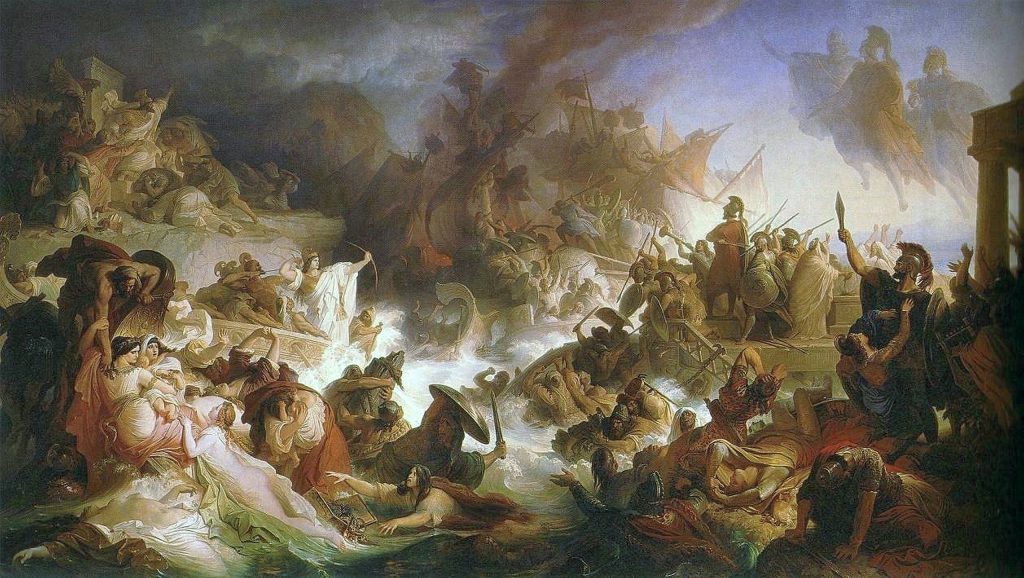
Kaulbach, Wilhelm von – Die Seeschlacht bei Salamis – 1868
On September 29, 480 BC, the Battle of Salamis took place, a naval battle between the Greek city-states under Themistocles and the Persian Empire under King Xerxes, which marked the high-point of the second Persian invasion of Greece.
Herodotus – the Father of History
Our main source for the Greco-Persian Wars is the Greek historian Herodotus, often referred to as the ‘Father of History’.[1] The Greek city-states of Athens and Eretria had supported the unsuccessful Ionian Revolt against the Persian Empire of Darius I in 499-494 BC. The Persian Empire was still relatively young, and prone to revolts amongst its subject peoples. Moreover, Darius was a usurper, and had spent considerable time extinguishing revolts against his rule. The Ionian revolt threatened the integrity of his empire, and Darius thus vowed to punish those involved, simultaneously taking the opportunity to expand his empire into the fractious world of Ancient Greece. A preliminary expedition under Mardonius, in 492 BC, to secure the land approaches to Greece ended with the re-conquest of Thrace and forced Macedon to become a client kingdom of Persia.
From Darius to Xerxes
In 491 BC, Darius sent emissaries to all the Greek city-states, asking for their submission to him, which the majority of Greek cities duly obliged. In Athens, however, the ambassadors were put on trial and then executed, in Sparta, they were simply thrown down a well, which equaled a direct declaration of war. He attacked Athens, landing at the bay of Marathon, where his troo met by a heavily outnumbered Athenian army. At the ensuing Battle of Marathon, the Athenians won a remarkable victory, which resulted in the withdrawal of the Persian army to Asia. When Darius died, the throne of Persia passed to his son Xerxes I, who quickly restarted the preparations for the invasion of Greece. He decided that the Hellespont would be bridged to allow his army to cross to Europe, and that a canal should be dug across the isthmus of Mount Athos, both feats of exceptional ambition. By early 480 BC, the preparations were complete, and Xerxes’ army marched towards Europe, crossing the Hellespont on two pontoon bridges.
Themistocles and the Athenian Fleet
The Athenians had also been preparing for war with the Persians since the mid-480s BC, and in 482 BC the decision was taken, under the guidance of the Athenian politician Themistocles, to build a massive fleet of triremes that would be necessary for the Greeks to fight the Persians. However, the Athenians did not have the manpower to fight on land and sea; and therefore combatting the Persians would require an alliance of Greek city states, and a confederate alliance of Greek city-states was formed in 481 BC. The route to southern Greece (Boeotia, Attica and the Peloponnese) would require the army of Xerxes to travel through the very narrow pass of Thermopylae. This could easily be blocked by the Greek hoplites, despite the overwhelming numbers of Persians. Famously, the much smaller Greek army held the pass of Thermopylae against the Persians for three days before being outflanked by a mountain path. Much of the Greek army retreated, before the Spartans and Thespians who had continued to block the pass were surrounded and killed.

Battle of Salamis, 1785 engraving
The Battle of Salamis
The Allied fleet now rowed from Artemisium to Salamis to assist with the final evacuation of Athens. Herodotus reports that there were 378 triremes in the Allied fleet, while the Persian fleet initially numbered 1,207 triremes. The overall Persian strategy for the invasion of 480 BC was to overwhelm the Greeks with a massive invasion force, and complete the conquest of Greece in a single campaigning season. Conversely, the Greeks sought to make the best use of their numbers by defending restricted locations and to keep the Persians in the field for as long as possible. If Xerxes could destroy the Allied navy, he would be in a strong position to force a Greek surrender; this seemed the only hope of concluding the campaign in that season. The Persians were at a significant tactical advantage, outnumbering the Allies, but also having “better sailing” ships. There has been much debate as to the nature of the Allied fleet compared to the Persian fleet. Much of this centres on the suggestion, from Herodotus, that the Allied ships were heavier, and by implication less maneuverable. The Persians preferred a battle in the open sea, where they could better utilize their superior seamanship and numbers. For the Greeks, the only realistic hope of a decisive victory was to draw the Persians into a constricted area, where their numbers would count for little.
The actual battle of Salamis is not well described by the ancient sources, and it is unlikely that anyone (other than perhaps Xerxes) involved in the battle had a clear idea what was happening across the width of the straits. The details of the rest of the battle are generally sketchy, and no one involved would have had a view of the entire battlefield. The Greek commander, Themistocles, lured the Persian fleet into the narrow waters of the strait at Salamis, where the massed Persian ships had difficulty maneuvering. The Greek triremes then attacked furiously, ramming or sinking many Persian vessels and boarding others. The Greeks sank about 300 Persian vessels while losing only about 40 of their own. The rest of the Persian fleet was scattered, and as a result Xerxes had to postpone his planned land offensives for a year, a delay that gave the Greek city-states time to unite against him. The Battle of Salamis was the first great naval battle recorded in history.[3]
A Turning Point in War
The Battle of Salamis marked the turning point in the Greco-Persian wars. Following defeat, Xerxes returned home to his palace at Sousa and left the gifted general Mardonius in charge of the invasion. The Persian position was still strong despite the defeat – they still controlled much of Greece and their large land army was intact. After a series of political negotiations, it became clear that the Persians would not gain victory on land through diplomacy and the two opposing armies met at Plataea in August 479 BCE. The Greeks, fielding the largest hoplite army ever seen, won the battle and finally ended Xerxes’ ambitions in Greece.[4]
Donald Kagan, 12. The Persian Wars, [6]
References and Further Reding:
- [1] Herodotus – the Father of History, SciHi Blog, Nov 25, 2015.
- [2] The Battle of Salamis at Wikipedia
- [3] The Battle of Salamis, at Britannica Online
- [4] Salamis, at Ancient History Encyclopaedia
- [5] The Battle of Salamis at Wikidata
- [6] Donald Kagan, 12. The Persian Wars, Introduction to Ancient Greek History (CLCV 205), YaleCourses @ youtube
- [7] Herodotus, The Histories Perseus online version
- [8] Blakesley, J. W. (1853) “On the Position and Tactics of the Contending Fleets in the Battle of Salamis (With a Map.)” in the Proceedings of the Philological Society.
- [9] Finley, Moses (1972). “Introduction”. Thucydides – History of the Peloponnesian War (translated by Rex Warner). Penguin.
- [10] Strauss, Barry (2004). The Battle of Salamis: The Naval Encounter That Saved Greece—and Western Civilization. New York: Simon and Schuster
- [11] Map with Naval Battles through history, via WIkidata





